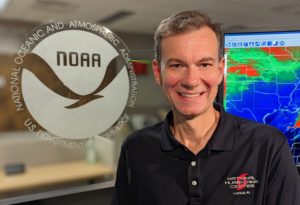
Ken Graham has been named as the new Director for the National Weather Service, a role that doubles as NOAA Assistant Administrator for Weather Services.
“Ken has the scientific integrity, trusted leadership, and communication prowess that will take the National Weather Service to even greater heights,” said NOAA Administrator Rick Spinrad, Ph.D. “I have full confidence that he will help create a more weather- and climate-ready nation amid more extreme weather fueled by our changing climate.”
NOAA, short for National Oceanic and Atmospheric Administration, is a scientific and regulatory agency within the Department of Commerce that forecasts weather, monitors oceanic and atmospheric conditions, conducts deep sea exploration, charts the seas, and manages fishing and the protection of marine mammals and endangered species in U.S. waters. NOAA tackles its mission through six major units: the National Environmental Satellite, Data, and Information Service (NESDIS), the National Ocean Service (NOS), the National Marine Fisheries Service (NMFS), the Office of Oceanic and Atmospheric Research (OAR), the Office of Marine and Aviation Operations (OMAO), and the National Weather Service (NWS.)

The NWS is tasked with “weather, hydrologic and climate forecasts and warnings for the US, its territories, adjacent waters and ocean areas, for the protection of life and property and the enhancement of the national economy.” To do that, the NWS, from its headquarters in Silver Spring, Maryland, runs six regional headquarters: Eastern, Southern, Central, Western, Alaska, and Pacific. Within these regions are 122 Weather Forecast Offices (WFO), 13 River Forecast Centers (RFCs), 21 Center Weather Service Units (CWSUs), as well as the Pacific Tsunami Warning Center and the National Tsunami Warning Center. Overall, the National Weather Service employs more than 4,000 people around the country, serving a variety of scientific, technical, and administrative posts.
“What an incredible honor it is to serve alongside the heroes of the National Weather Service whose excellence shines through day after day,” said Graham. “I thank Dr. Spinrad for entrusting me with the awesome responsibility and privilege of leading this dedicated team at such an exciting and important time in our history. We’ll accomplish great things together by building on recent progress and prioritizing support of our forecasters. I can’t wait to get started.”
Since April 2018, Graham has served as the director of the National Hurricane Center, leading the nation through numerous hurricanes, including 30 named storms during the record-breaking 2020 hurricane season.
“Ken has a long history of providing dependable impact-based decision support services in all positions in which he served, and which will greatly serve the nation as he leads the National Hurricane Service,” Louis Uccellini, the then-Director of the National Weather Service said.

Uccellini retired from public service on January 1 of this year. has enjoyed a 43-year illustrious career in public service as a research scientist, day-to-day operational leader and senior executive, with 11 years at NASA and 32 years at the NWS. He had served as the NWS director for nearly nine years, having previously served as director for the agency’s National Centers for Environmental Prediction for 14 years. Combined with 10 years as a student and postdoc at the University of Wisconsin-Madison, Uccellini has dedicated more than 50 years to the field of meteorology.
When Uccellini retired, Deputy Director of the National Weather Service, Mary C. Erickson, became Acting Director of the NWS. With Graham now at the helm of the NWS, Erickson remains the Deputy Director.
“Ken is highly respected across the agency as an inspirational leader, tireless builder of trusted partnerships, and consummate champion of the workforce. We look forward to welcoming him back to National Weather Service headquarters, where he will undoubtedly excel in leading the agency into a bright future,” said Erickson.
Graham is no stranger to the National Weather Service, bringing to the new position a significant amount of operational field experience. He worked his way up through the ranks at NWS, mostly in field offices, starting at the ground level as a meteorology intern in 1994 at the weather forecast office in New Orleans. Before joining the National Hurricane Center, Graham served as the meteorologist-in-charge of the NWS New Orleans/Baton Rouge office for 10 years. He notably established two command centers in the wake of the Deepwater Horizon oil spill in 2010 that provided forecasts to help authorities make critical decisions in the five months following the spill. Graham also led the effort to support decision makers in Louisiana and Mississippi with services focused on expected impacts for hurricanes Gustav, Ike, Isaac, and during the historic 2017 season.
Prior to leading the New Orleans/Baton Rouge forecast office, Graham served as the systems operations division chief at NWS’ Southern Region headquarters in Fort Worth, Texas, where he led Hurricane Katrina recovery efforts. He also served as the meteorological service chief at NWS headquarters in Silver Spring, Maryland, and was the meteorologist-in-charge at the local forecast offices in Birmingham, Alabama, and Corpus Christi, Texas.

Graham earned a bachelor’s degree in atmospheric science from the University of Arizona and a master’s degree in geoscience from Mississippi State University.
Jamie Rhome, deputy director of the National Hurricane Center, will assume the role of acting director until a permanent director is named. Rhome has served in a variety of roles at the Hurricane Center since 1999, from forecaster to hurricane and storm surge specialist. Michael Brennan, Ph.D., branch chief of the hurricane specialist unit, will serve as the acting deputy director of the Center for the coming hurricane season.